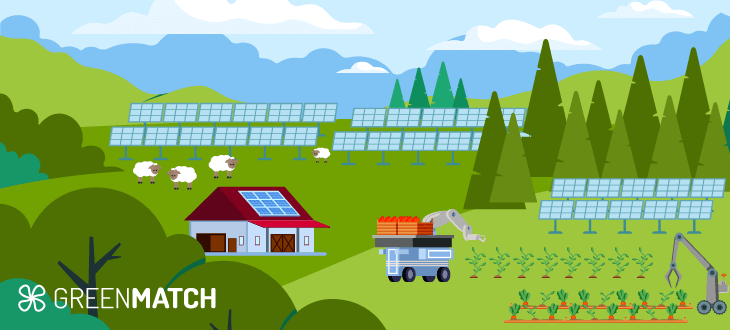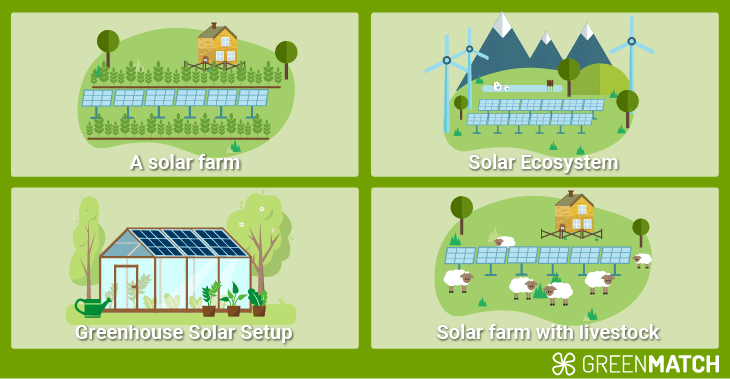- GreenMatch
- Blog
- Agrovoltaics: Solar Energy for Sustainable Farming
Agrovoltaics: Solar Energy for Sustainable Farming


- Agrovoltaics combines farming with solar energy, boosting land efficiency by up to 186% and increasing crop yields.
- Solar panels over crops conserve water, reduce evaporation, and protect plants from extreme weather.
- This system offers farmers dual income from crops and solar energy, enhancing economic sustainability.
- Global adoption of agrovoltaics is growing, with significant market expansion projected by 2033.
Agrovoltaics combines farming with solar energy, creating a win-win situation for food and power production. This innovative method places solar panels over crops, allowing farmers to grow food and generate electricity on the same land.
As the world's population grows, the need for both food and clean energy increases. Agrovoltaics offers a smart solution that uses land more efficiently.
In 2021, solar power capacity grew significantly, showing its potential to meet energy needs. Yet, only a small fraction of farmland uses agrovoltaics. This means there's a huge opportunity to expand this approach. Studies show that using agrovoltaics can make land use up to 186% more efficient than using land separately for farming and solar energy.
In the UK alone, adopting agrovoltaics could significantly contribute to meeting energy goals while supporting farmers.
By shading crops, solar panels reduce water loss and protect plants from extreme weather, improving yields and resilience.
What is Agrovoltaic Farming?
Agrovoltaics, or agrophotovoltaics, use the same land for farming and solar energy generation. This innovative method, also known as dual-use solar or agrisolar, allows us to generate clean electricity while growing crops or providing space for grazing.
Agrovoltaics offers a promising solution to challenges faced by rural farmers, including land scarcity and rising energy costs. Integrating solar panels with agricultural activities can optimise land use efficiency and create a synergistic effect between food production and renewable energy generation.
History and Development
The concept of agrovoltaics dates back to the early 1980s when German physicist Adolf Goetzberger and his colleague Armin Zastrow first proposed this innovative idea. Their vision was to address the dual challenge of producing sufficient food and energy for a rapidly growing global population while preserving our planet's limited resources.
Since its inception, agrovoltaics has been implemented in various parts of the world. Japan embraced this concept in 2004, followed by widespread adoption in Europe and Asia. Interestingly, different regions have given this practice unique names. In Italy, it's called "Agrovoltaics," while Germans call it "Agrophotovoltaics." In Asia, it's commonly known as "solar sharing."
Types of agrovoltaic systems
We can categorise agrovoltaic systems into three main types:
- Elevated systems: Solar panels are placed directly above vegetation, typically at least 6 feet high. These systems can protect crops from extreme weather and reduce sun exposure. They're particularly suitable for berries, grapes, and apples.
- Inter-row systems: Vegetation grows between rows of solar panels. While offering less weather protection, these systems allow crops more direct sunlight access. They're ideal for grasses, grains, and hardy vegetables like kale and broccoli.
- Combination systems blend elements of elevated and inter-row configurations to maximise benefits.
Recent advancements in agrovoltaics include dynamic systems with adjustable panels and monitoring systems that optimise panel orientation based on crop needs and weather conditions. Future developments may even see semi-transparent solar panels allowing specific light wavelengths to pass through for photosynthesis.
Benefits of Agrovoltaics
This system offers numerous advantages:
Increased Land-use Efficiency
We've discovered that agrovoltaics offers a remarkable solution to maximise land use. Combining solar energy production with agriculture on the same plot can achieve up to 186% land-use efficiency. This dual-purpose approach allows us to simultaneously address food and energy security challenges, making the most of our available land resources.
Improved Crop Yields
Surprisingly, integrating solar panels with farming has significantly boosted crop yields. Studies reveal that agrovoltaic systems increase yields by 20% to 60%, depending on the crop type. For instance, forage crops grown between solar panel rows have shown a 40% increase in yield, while peppers have demonstrated an impressive 60% boost. The panels provide partial shade, creating a favourable microclimate that protects plants from excessive heat and sunlight, improving growth conditions.
Water Conservation
One of the most significant benefits of agrovoltaics is its potential for water conservation. Solar panels provide partial shade, reducing evaporation and allowing soil to retain more moisture. This effect has led to a decrease in irrigation needs by up to 20% and, in some cases, even up to 30%. For farmers facing water scarcity issues, this water-saving aspect of agrovoltaics is particularly valuable, enabling them to grow more crops with the same amount of water.
Clean Energy Generation
Agrovoltaic systems offer a sustainable solution for clean energy production. If just 1% of arable land were dedicated to solar energy production, it could offset the world's energy demand. This approach helps combat climate change by reducing carbon emissions and provides farmers with an additional income stream. The electricity generated by these systems can be used for farm operations or sold back to the grid, potentially increasing the economic value of agrovoltaic farms by more than 30%
Environmental Impact
Agrovoltaics reduces greenhouse gas emissions by generating renewable energy. A study showed that carbon emissions were reduced by 12% on agrovoltaic systems compared to conventional farming practices. By combining solar energy production with agriculture, agrovoltaics helps preserve natural habitats and reduce the need for separate solar farms, thereby limiting land conversion.
Economic Gains
Agrovoltaics provides economic benefits by offering farmers additional revenue streams. Farmers can generate income from crop sales and solar energy production, which can help offset the costs of implementing solar technology. Farmland lease prices for photovoltaic system installations can be significantly higher than traditional farming, providing a substantial increase in income for farmers.
Environmental Impact of Agrovoltaics
Agrovoltaic systems contribute to climate change mitigation by reducing greenhouse gas emissions associated with traditional energy production. The renewable energy generated by solar panels can offset the need for fossil fuel-based electricity, decreasing carbon dioxide (CO2) and other greenhouse gas emissions.
It is estimated that agrovoltaic farms could reduce emissions by 330,470 metric tonnes of CO2 equivalent annually, comparable to removing over 71,000 cars from the road.
These systems simultaneously address multiple environmental challenges by reducing greenhouse gas emissions, promoting biodiversity, and preserving agricultural land. Integrating renewable energy with sustainable farming practices is a powerful tool in our efforts to create a more sustainable future.
Statistics, Facts, and Figures About Agrovoltaics Solar Energy
Countries worldwide are exploring agrovoltaics to boost agricultural resilience to climate change and enhance rural electrification. Key statistics indicate that As technology advances, it is expected to play a vital role in addressing climate change and ensuring food security.
In the meantime, we analysed recent reports, academic studies, and industry data on agrivoltaics from 2022-2024. We focused on quantitative statistics and verifiable facts from reputable sources. This information provides an evidence-based overview of agrivoltaics' potential for sustainable agriculture and renewable energy.
Statistics on Agrovoltaics
- By combining solar panels with agriculture, land use efficiency can reach up to 186% compared to using land separately for farming and solar energy.
- The economic value of agrovoltaics farms can increase by over 30% due to the dual use of land, which boosts productivity and energy generation.
- The global agrovoltaics market is expected to grow from £2.7 billion in 2023 to £7.1 billion by 2033, with a compound annual growth rate of 10.05%.
- There are currently over 1,000 agrovoltaics projects in operation around the world.
- The countries with the most agrovoltaics projects are China, the United States, and Japan.
- The most common crops grown under agrovoltaics are berries, vegetables, and grains.
- Agrivoltaic systems can boost land productivity by 35-73%.
- Combining solar panels with agriculture improves panel efficiency by 2-6 degrees.
- Agrivoltaics requires just 1% of EU arable land (950,000 hectares) to deploy 900 GW solar capacity.
- 14 EU member states plan to support solar PV through agricultural policy frameworks
- Net income for farmers can increase up to 142% through agrivoltaics.
- Even with 10-30% lower crop yields, combined agrivoltaic income is 30-50% higher.
- Italy invested £950 million to support agrivoltaic development.
- France aims for 375 MW of agrivoltaic capacity by 2024.
- Initial Investment could be up to £375,000 for 1MWh generation on 5 acres.
- Return on investment in the UK 10% to 20%.
- The UK market is expected to grow at a CAGR of 11.96%, driven by the need for renewable energy and sustainable farming practices.
Crop Benefits
- Tomato yields increase by 11% under agrivoltaic systems.
- Lettuce yields rise 38% when grown beneath solar panels.
- Cotton production jumps 33% in agrivoltaic setups.

Can Agrovoltaics Solar Energy for Farming be Sustainable?
So far, we have found that maximising land use efficiency addresses food and energy security challenges.
The growing demand for sustainable solutions will likely drive further adoption and innovation. In addition, based on current data and statistics, agrovoltaics - combining solar energy with farming - show promise for sustainability.
- Agrovoltaics increases land productivity by up to 60%. Farms using this approach generate clean energy while growing crops, maximising land use.
- Studies show crop yields under solar panels can rise 20% on average. Partial shade from panels reduces water needs and protects plants from extreme weather.
- Water usage decreases by about 30% in agrovoltaic systems. Panels provide shade, lowering evaporation and irrigation requirements.
- Energy generation averages 8 MWh per hectare annually in these dual-use setups. This clean power reduces reliance on fossil fuels.
Moreover, initiatives demonstrate that agrovoltaics can be a sustainable solution for farming and solar energy production, offering benefits such as increased crop yields, water conservation, and additional income for farmers.
European Agrovoltaic Projects
Europe has embraced agrovoltaics with enthusiasm. The EU Solar Energy Strategy encourages member countries to integrate incentives for agrovoltaics in their national plans. Covering just 1% of the utilised agricultural area with agrovoltaic systems could result in approximately 944 GWDC of installed capacity, surpassing the 2030 target of 720 GWDC.
Thanks to advanced technology and supportive policies, Germany has seen rapid growth in agrovoltaics. The LIFE ADAPT-PV project, for instance, uses translucent photovoltaic panels over fruit crops to protect them from extreme weather and create a stable microclimate.
Other European countries have implemented supportive policies. Italy has allocated €1.1 billion for agri-PV development, aiming for more than 1GW capacity. Austria offers a 30% additional investment subsidy for agri-PV projects.
France, Europe's largest agri-PV market, has set clear rules balancing food sovereignty and energy independence. The Netherlands provides specific support through its CAP Strategic Plan.
Asian Agrovoltaic Initiatives
China leads agrovoltaics, with over 500 projects showcasing the technology's potential. In Dongying City, farmers have seen a 50% increase in shrimp and sea cucumber yields thanks to solar panels installed above their ponds.
Japan pioneered 'solar sharing' systems in 2004, combining solar energy production with various food crops. These systems, with PV panels mounted on 3-metre-high poles, allow crops like peanuts, yams, and cabbages to be cultivated.
North American Implementations
The USA has begun exploring agrovoltaics, with a small-scale research plant installed in Arizona as part of the Biosphere 2 research facility. Plans are underway to set up more testing sites in rural Arizona and northern Mexico.
Developing World Applications
Agrovoltaics holds great promise for developing countries. In Mali and The Gambia, a project supported by the German Federal Ministry of Education and Research aims to improve productivity and resilience in the agriculture sector. The project plans to construct a 200-kilowatt-peak system in Mali and four smaller systems in The Gambia.
Cost-benefit Analysis of Agrovoltaics
When considering agrovoltaic systems, we must carefully weigh costs against potential benefits. The initial investment in these systems can be substantial, with solar panel costs often higher than traditional energy options. However, the long-term economic advantages can be significant, especially for high-value crops.
For instance, in some Italian regions, potato cultivation could combine with agrovoltaics to achieve profitability without additional financial support. Conversely, for lower-revenue cropland activities, the high costs of agrovoltaic infrastructure may require external financial support to be economically viable.
Farmers can sometimes lease their land to solar PV companies, providing a consistent and predictable income that helps mitigate the impact of fluctuating crop yields and market prices.
Moreover, government support plays a crucial role in making agrovoltaics financially attractive. For example, the Improving Farm Productivity (IFP) solar grant in the UK covers 25% of the capital for a wide range of equipment, including solar PV panels, battery storage, and installation costs. Grants range from £15,000 to £100,000, making it easier for farmers to adopt this technology.
Consequently, the long-term economic sustainability of agrovoltaics depends on various factors, including crop type, location, and system design. While the extra income from electricity production can be significant, the repayment period may only sometimes be favourable for investors with subsidies. However, agrovoltaics can enhance energy independence and create employment opportunities in rural areas, contributing to local economic growth.
Global Adoption and Policy Landscape
Various countries provide financial incentives to promote the adoption of agrovoltaics. These include grants, tax breaks, and competitive tariffs to make the technology more accessible to farmers and energy producers.
Europe is leading in adopting agrovoltaic systems. Countries like Germany, France, and Italy are integrating these systems into their energy and agricultural policies. Germany, for example, has a high potential for agrovoltaics due to its large farming areas and commitment to renewable energy.
Italy, for instance, has also allocated significant funds to support agrovoltaic projects, aiming for over 1 GW of development.
In Asia, countries like China are scaling agrovoltaic projects to the gigawatt level, showcasing the potential for large-scale implementation. The focus is reducing costs and developing policies supporting collaboration between the agricultural and energy sectors.
We expect the sector to scale up, moving beyond MW to GW scale projects. However, challenges remain, including cost reduction, policy framework development, and strengthening cooperation with the agricultural sector.
Market Growth
The global market for this innovative technology will experience significant growth in the coming years.
The agrovoltaics market is experiencing rapid growth, with projections indicating a substantial increase in market size. The market is expected to grow from £2,013.8 million in 2023 to £9,120.0 million by 2025, reflecting a strong annual growth rate.
The market is projected to reach around £12.5 billion by 2033, with a compound annual growth rate of 22.9%.
| Country | Total Projects (GW) | Market Value (£ billion) | Policy Initiatives |
|---|---|---|---|
| Italy | 2.8 | 4.5 | Scheme support |
| France | 1.5 | 3.5 | Incentives for research |
| Germany | 4.0 | 5.0 | Regulatory frameworks |
| Spain | 3.0 | 2.0 | Tax incentives |
| Netherlands | 2.0 | 1.5 | Innovation grants |
| Year | Market Size (£m) | Growth Rate (%) |
|---|---|---|
| 2023 | 2,013.8 | 22.93 |
| 2024 | 4,587.3 | 25.10 |
| 2025 | 9,120.0 | 27.50 |
Challenges and Opportunities
- High Installation Costs: Setting up agrovoltaic systems can be expensive, but long-term benefits and government incentives can offset initial costs.
- Crop Compatibility: Not all crops thrive under solar panels, so selecting suitable crops is crucial for success.
- Dual Revenue Streams: Farmers can earn from energy production and agriculture, making agrovoltaics an attractive option.
- Technical Challenges: Integrating solar panels with farming requires careful planning to ensure that crops receive enough sunlight and that farming activities do not damage the panels.
The Future of Agrovoltaics
Agrovoltaics presents a promising future for sustainable energy and agriculture. This innovative approach can significantly contribute to global energy and food security by addressing challenges and leveraging opportunities.
Moreover, dynamic panel systems contribute significantly to market growth, with an 86.4% share in 2024. Root crops like potatoes and carrots also play a strong role, representing a 42.2% share in the same year.
According to a recent study by the International Energy Agency, the global capacity of agrovoltaic systems is expected to reach 100 gigawatts by 2030. This represents a significant increase from the current level of 2 gigawatts.
With the UK government’s focus on renewable energy, agrovoltaics could significantly meet future energy demands. Integrating this approach into farming practices can help secure a sustainable future for food production and energy supply.
As this technology develops, it could become a key part of the energy strategy, benefiting farmers and the broader community.

Inemesit is a seasoned content writer with 9 years of experience in B2B and B2C. Her expertise in sustainability and green technologies guides readers towards eco-friendly choices, significantly contributing to the field of renewable energy and environmental sustainability.
We strive to connect our customers with the right product and supplier. Would you like to be part of GreenMatch?

Stay up to date with energy saving tips and grant alerts
Receive offers, marketing and promotions via email from Leads.io about GreenMatch and our brands/partners to help you save.
Thank you for subscribing to our newsletter!
Your email has been successfully added to our list. We look forward to sharing our latest updates with you soon!
